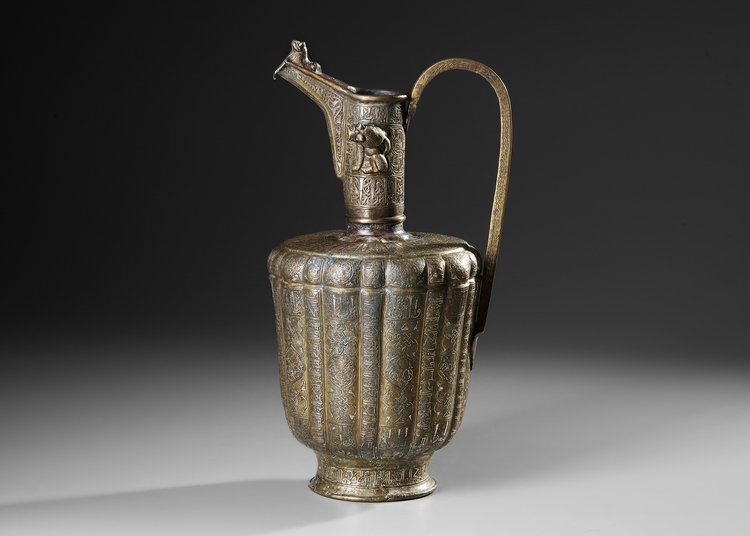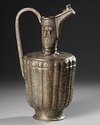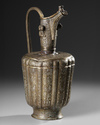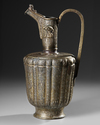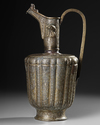A SILVER AND COPPER INLAID EWER, 12TH CENTURY
Of fluted tapering drum shaped short foot, with tall tubular neck rising to an angled spout and with square section loop handle, the body lavishly inlaid with vertical bands or cartouches terminating in knots, a continuous band of horizontal naskh inscription running above and below the foot with similar horizontal Kufic inscription band, the flat shoulder with wide band of elegant naskh, the bevelled mouth with spiraling arabesques surmounted by a smaller repoussé lion, the handle with simple S-motif, all inscription bands inlaid with silver, almost all silver present, slight rubbing to high points, denting to shoulder.
Height: 38 cm.
The naskh inscriptions on the top of the shoulder read: al-'izz w'al-iqbal w'al-dawla w'al-sa'ada w'al-'inayat w'al-qana'a w'al-dawama w'al-shafa'a w'al-qura'a(?) w'al-'inayat w'al-baqa [li-sa]hibihi wa (glory, prosperity, wealth, happiness, providence, contentment, perpetual cure (from ills), ....., contentment and long life to the owner.
Those around the base of the neck: al-'izz w'al-iqbal w'al-dawla w'al-tamma (glory, prosperity, wealth and completeness.)
Those around the mouth: al-'izz, w'al-iqbal w'al-la w'al-la w'al-tamma w'al-l w'al-tamma wa.
Both registers of naskh around the body contain similar inscriptions, some of the words of which are fully formed but many of which are partial or even stylized.
The Kufic inscription around the foot reads: b'il-yumn w'al-baraka w'al-dawla w'al-surur w'al-sa'ada w'al-salama w'al-baqa w'al-.... w'al-karama w'al-nasr w'al-nasr (with good fortune, blessing, wealth, joy, happiness, peace, long life, ..., nobility, victory and that which makes victorious.)
The vertical bands of Kufic running down the main body have similar and considerably more extensive contents, most of which are fully literate.
This ewer is an extremely well executed and well-preserved example of a frequently encountered type. Not only are the inscriptions very extensive, well-delineated and inlaid, but the repoussé lions stand remarkably proud of the surface either side of the neck, recalling much earlier prototypes of lions in the round flanking the shafts of Luristan axe heads. The lion sitting on top of the spout is also far more than the usual apology for a feline, sitting comfortably with head held proudly. While the type is well-known, and was copied in Western Persia as well, this retains the purity of decoration so typical of the eastern provinces. Its decorative repertoire is very close indeed to that of an ewer in the Victoria and Albert Museum (Melikian-Chirvani, A.S.: Islamic Metalwork from the Iranian World, 8th-18th centuries, London, 1982, no.45, pp.114-118. The only differences between the two is the upper band of inscription around the neck which here is naskh while the other is Kufic. The execution of the present piece, and particularly the repoussé lions, is however certainly crisper and stronger here than in the Victoria and Albert example.
